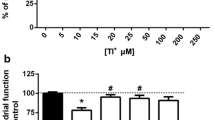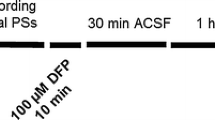Abstract
This study examined whether maturity of rat brain may be relevant for the sensitivity to diphenyl diselenide (PhSe)2 and diphenyl ditelluride (PhTe)2 on [3H]glutamate uptake and release, in vitro. Brain synaptosomes were isolated from young (14- and 30-day-old) and adult rats and incubated at different concentrations of (PhSe)2 or (PhTe)2. The results demonstrated that the highest concentration (100 μM) of (PhSe)2 and (PhTe)2 inhibited the [3H]glutamate uptake by synaptosomes of brain at all ages. In the adult brain, (PhSe)2 did not inhibit the [3H]glutamate uptake at the lowest concentration (10 μM). The highest concentration of (PhTe)2 inhibited the [3H]glutamate uptake more in the 14-day-old than in the 30-day-old rats or adult rats. In the 30-day-old animals, the highest concentration of (PhSe)2, and the lowest concentration of (PhTe)2, increased the basal [3H]glutamate release. At the highest concentration, (PhTe)2 increased the basal and K+-stimulated glutamate release on all ages evaluated. The results suggest that (PhSe)2 and (PhTe)2 caused alterations on the homeostasis of the glutamatergic system at the pre-synaptic level. These alterations were age-, concentration-, and compound-dependent. The maturity of rat brain is relevant for the glutamatergic system sensitivity to (PhSe)2 and (PhTe)2 .



Similar content being viewed by others
References
Ozawa S, Kamiya H, Tsukuki K (1998) Glutamate receptors in the mammalian central nervous system. Progr Neurobiol 54:581–618
Longuemare MC, Swanson RA (1995) Excitatory amino acid release from astrocytes during energy failure by reversal of sodium-dependent uptake. J Neurosci Res 40:379–386
Bock A, Forchammer JH, Leinfelder W, Sawers G, Vepreck B, Zinnia F (1991) Selenocysteine: the 21st amino acid. Mol Microbiol 5:515–520
Parnham M, Sies H (2000) Ebselen: prospective therapy for cerebral ischaemia. Expert Opin Invest Drug 9:607–619
Schroeder HA, Buckman J, Balassa JJ (1967) Abnormal trace elements in man: tellurium. J Chronic Dis 20:147–161
Taylor A (1996) Biochemistry of tellurium. Biol Trace Elem Res 55:231–239
Meotti FC, Stangherlin EC, Zeni G, Nogueira CW, Rocha JBT (2004) Protective role of aryl and alkyl diselenides on lipid peroxidation. Environ Res 94:276–282
Nogueira CW, Zeni G, Rocha JBT (2004) Organoselenium and organotellurium compounds: toxicology and pharmacology. Chem Rev 104:6255–6285
Prigol M, Schumacher RF, Nogueira CW, Zeni G (2009) Convulsant effect of diphenyl diselenide in rats and mice and its relationship to plasma levels. Toxicol Lett 189:35–39
Nogueira CW, Quinhones EB, Jung EAC, Zeni G, Rocha JBT (2003) Evidence for anti-inflammatory and antinociceptive activity for diphenyl diselenide. Inflamm Res 52:56–63
Savegnago L, Trevisan M, Alves D, Rocha JBT, Nogueira CW, Zeni G (2006) Antisecretory and antiulcer effects of diphenyl diselenide. Environ Toxicol Pharmacol 21:86–92
Acker CI, Luchese C, Prigol M, Nogueira CW (2009) Antidepressant-like effect of diphenyl diselenide on rats exposed to malathion: involvement of Na+K+ATPase activity. Neurosci Lett 455:168–172
Stangherlin EC, Luchese C, Ardais AP, Nogueira CW (2009) Passive smoke exposure induces oxidative damage in brains of rat pups: Protective role of diphenyl diselenide. Inhal Toxicol 21:868–874
Prigol M, Wilhelm EA, Schneider CC, Rocha JBT, Nogueira CW, Zeni G (2007) Involvement of oxidative stress in seizures induced by diphenyl diselenide in rat pups. Brain Res 1147:226–232
Prigol M, Wilhelm EA, Stangherlin EC, Barancelli DA, Nogueira CW, Zeni G (2008) Diphenyl diselenide-induced seizures in rat pups: possible interaction with glutamatergic system. Neurochem Res 33:996–1004
Stangherlin EC, Favero AM, Zeni G, Rocha JBT, Nogueira CW (2005) Teratogenic vulnerability of Wistar rats to diphenyl ditelluride. Toxicology 207:231–239
Stangherlin EC, Favero AM, Zeni G, Rocha JBT, Nogueira CW (2006) Exposure of mothers to diphenyl ditelluride during the suckling period changes behavioral tendencies in their offspring. Brain Res Bull 69:311–317
Stangherlin EC, Ardais AP, Rocha JBT, Nogueira CW (2009) Exposure to diphenyl ditelluride, via maternal milk, causes oxidative stress in cerebral cortex, hippocampus and striatum of young rats. Arch Toxicol 83:485–491
Stangherlin EC, Rocha JBT, Nogueira CW (2009) Diphenyl ditelluride impairs short-term memory and alters neurochemical parameters in young rats. Pharmacol Biochem Behav 91:430–435
Nogueira CW, Rotta LN, Perry ML, Souza DO, Rocha JBT (2001) Diphenyl diselenide and diphenyl ditelluride affect the rat glutamatergic system in vitro and in vivo. Brain Res 906:157–163
Nogueira CW, Rotta LN, Zeni G, Souza DO, Rocha JBT (2002) Exposure to ebselen changes glutamate uptake and release by rat brain synaptosomes. Neurochem Res 27:283–288
Paulmier C (1986) Selenium reagents and intermediates in organic synthesis, 1st edn. Pergamon press, Oxford
Petragnani N (1994) Preparation of the principal classes of organic tellurium compounds. In: Katritzky AR, Meth-Cohn O, Rees CW (eds) Tellurium in organic synthesis. Academic Press, London, pp 9–88
Dunkley PR, Heath J, Harrison SM, Jarvie PE, Glenfield PY, Rostas JAP (1988) A rapid gradient procedure for isolation of synaptosomes directly from an S-1 fraction-homogeneity and morphology of subcellular fractions. Brain Res 441:59–71
Lowry OH, Rosebrough NJ, Farr AL, Randall RJ (1951) Protein measurement with the Folin phenol reagent. J Biol Chem 193:265–275
Migues PV, Leal RB, Mantovani M, Nicolau M, Gabilan NH (1999) Synaptosomal glutamate release induced by the fraction Bc2 from the venon of the sea anemone Bunodosoma caissarum. Neuroreport 10:67–70
Robinson MB, Dowd LA (1997) Heterogeneity and functional subtypes of sodium-dependent glutamate transporters in the mammalian central nervous system. Adv Pharmacol 37:69–115
Fykse EM, Fonnum F (1996) Amino acid neurotransmission: dynamics of vesicular uptake. Neurochem Res 21:1053–1060
Danbolt NC (1994) The high affinity uptake system for excitatory amino acids in the brain. Progr Neurobiol 44:377–396
Wolosker H, Reis M, Assreuy J, de Meis L (1996) Inhibition of glutamate uptake and proton pumping in synaptic vesicles by S-nitrosylation. J Neurochem 66:1943–1948
Moretto MB, Rossato JI, Nogueira CW, Zeni G, Rocha JBT (2003) Voltage-dependent ebselen and diorganochalcogenides inhibition of Ca-45(2+) influx into brain synaptosomes. J Biochem Mol Toxicol 17:154–160
Maciel EN, Bolzan RC, Braga AL, Rocha JBT (2000) Diphenyl diselenide and diphenyl ditelluride differentially affect d-Aminolevulinate dehydratase from liver, kidney, and brain of mice. J Biochem Mol Toxicol 14:310–319
Götz ME, Künig G, Riederer P, Youdim MBH (1994) Oxidative stress: free radical production in neural degeneration. Pharmacol Ther 63:37–122
Patel M, Day BJ, Crapo JD, Fridovich I, McNamara JO (1996) Requirement for superoxide in excitotoxic cell death. Neuron 16:345–355
Coyle JT, Puttfarchen P (1993) Oxidative stress, glutamate, and neurodegenerative disorders. Science 26:689–695
Borges VC, Rocha JB, Nogueira CW (2005) Effect of diphenyl diselenide, diphenyl ditelluride and ebselen on cerebral Na(+), K(+)-ATPase activity in rats. Toxicology 215:191–197
Beal MF, Hyman BT, Koroshetz W (1993) Do defects in mitochondrial energy metabolism underlie the pathology of neurodegenerative diseases. Trends Neurosci 16:125–131
Nogueira CW, Meotti FC, Curte E, Pilissão C, Zeni G, Rocha JBT (2003) Investigations into the potential neurotoxicity induced by diselenides in mice and rats. Toxicology 183:29–37
Perez-D’Gregorio RE, Miller RK (1988) Teratogenicity of tellurium dioxide: prenatal assessment. Teratology 37:307–316
Muller R, Zschiesche W, Steffen HM, Schaller KH (1989) Tellurium-intoxication. Klin Wochenschr 67:1152–1155
Spiller HA, Pfiefer E (2007) Two fatal cases of selenium toxicity. Forensic Sci Int 171:67–72
Morgane JP, Mokler JD, Galler RJ (2002) Effets of prenatal protein malnutrition on the hipocampal formation. Neurosci Biobehav Rev 26:471–483
Wolff JR, Balcar VJ, Zetzsche T, Böttcher H, Schmechel DE, Chronwall BM (1984) Development of GABA-ergic system in rat visual cortex. Adv Exp Med Biol 181:215–239
Olney JW (1980) Excitatory neurotoxins as food additives: an evaluation of risk. Neurotoxicology 2:153–192
Acknowledgments
The financial support by FAPERGS, CAPES, and CNPq is gratefully acknowledged. C. W. N. is the recipient of CNPq fellowship.
Author information
Authors and Affiliations
Corresponding author
Rights and permissions
About this article
Cite this article
Souza, A.C.G., Stangherlin, E.C., Ardais, A.P. et al. Diphenyl diselenide and diphenyl ditelluride: neurotoxic effect in brain of young rats, in vitro. Mol Cell Biochem 340, 179–185 (2010). https://doi.org/10.1007/s11010-010-0416-7
Received:
Accepted:
Published:
Issue Date:
DOI: https://doi.org/10.1007/s11010-010-0416-7




